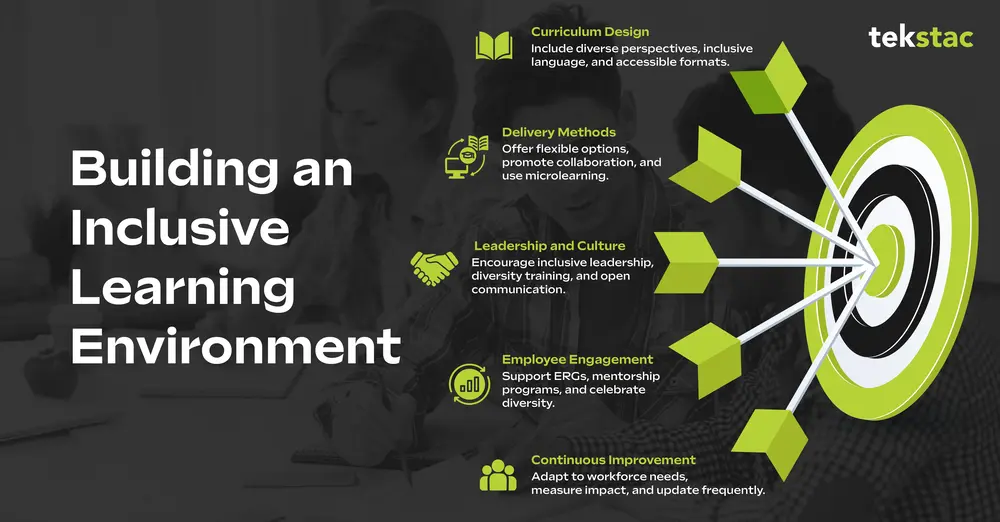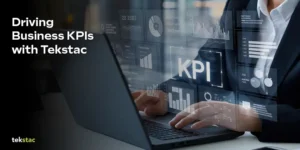How to Create an Inclusive Learning Environment for a Diverse Workforce
December 4, 2024

Creating an inclusive learning environment means building a space where everyone feels welcome, valued, and supported. It’s about making sure everyone, regardless of background, can learn, grow, and contribute freely. In modern workplaces, inclusive learning helps teams understand each other better, share different perspectives, and work together more effectively.
According to Forbes report, inclusive teams make decisions 60% faster and are 87% more likely to make better decisions on average.
Organizations thrive when employees feel valued and respected, regardless of their background. So, how can we create learning environments that truly support this dynamic?
Let’s dive into the critical elements of inclusivity and the strategies to integrate them within your team.
Understanding Diverse Workforces in an Inclusive Learning Environment
A diverse workforce brings together people with different backgrounds, experiences, and perspectives within an organization. It’s more than just demographics. It’s about creating an environment where unique talents and viewpoints are valued and empowered.
- Age: Multigenerational teams promote learning across all age groups.
- Gender: Diverse gender participation reduces bias.
- Ethnicity and Culture: Different cultural backgrounds bring fresh perspectives.
- Abilities: Neurodivergent and differently-abled employees offer unique skills and insights.
Diversity means embracing individual differences to drive innovation, creativity, and collective success. It’s about recognizing that each person brings something unique to the team, helping organizations become more adaptable, dynamic, and competitive.
Personalized learning approaches can further enhance workforce diversity by content to individual learning needs and strengths.
When paired with an inclusive learning environment, diverse workforces lead to exponential improvements in employee satisfaction, knowledge retention, and long-term business agility.
What Does an Inclusive Learning Environment Look Like?
An inclusive learning environment is where every employee feels heard, respected, and empowered to learn. It’s about more than just accommodating differences; it’s celebrating them. Characteristics of such environments include:
- Valuing All Voices: Ensuring every individual feels their input matters.
- Respect for Diversity: Acknowledging and respecting cultural, social, and personal differences.
- Flexible Learning Approaches: Adapting teaching methods to accommodate various learning styles.
When inclusivity is prioritized, employees absorb knowledge and feel more confident sharing their perspectives, driving innovation across the board.
Benefits of an Inclusive Learning Environment for a Diverse Workforce
A good, inclusive learning environment supports a diverse workforce in engaging employees, improving collaboration, and lowering the risk of biases in the workplace.
According to Achievers report, engagement of 83% of millennials, organizations that value diversity and inclusion experience higher productivity and morale.
1. Improved Employee Engagement
An inclusive learning environment fosters a sense of belonging. When employees see that their unique contributions matter, they feel valued, which directly impacts their engagement levels. Engaged employees are more productive, innovative, and committed to their roles.
It’s the difference between an employee simply clocking in and one who’s genuinely invested in the company’s success.
2. Better Collaboration and Innovation
That difference of thought is the key to diffusing problem-solving. Think of it like a recipe: the more ingredients you have, the richer the flavor. In an inclusive setting, teams are more likely to explore creative solutions or take calculated risks, which results in some groundbreaking solutions.
For instance, like the ones discussed, internal mobility strategies can boost employees in moving to positions where their inherent strengths outnumber their deficiencies.
3. Reduced Workplace Bias
Bias in the workplace, intentional or not, can create barriers to collaboration. Inclusive learning environments actively work to break down these biases. Employees learn to appreciate each other’s differences by focusing on empathy and understanding.
This reduces interpersonal conflicts and encourages harmonious relationships, benefiting the organization as a whole.
Key Strategies to Build an Inclusive Learning Environment for a Diverse Workforce
Strategies It is essential to provide trainers with the means to develop learners in diverse groups using open communication and flexible formats of learning. These efforts align with modern workplace learning strategies that prioritize inclusivity, adaptability, and accessibility.
To supplement this, there’s leadership support and regular different training. If organizations implement these strategies, they will be able to create a conducive environment where every employee is valued and empowered to excel.

1. Curriculum Design
If the curriculum is well designed, inclusion is set by having diverse perspectives and accessible materials. A producer of training content should provide examples and case studies of training content with diverse cultural backgrounds, genders, and abilities.
This means employees will see their own realities through the learning experience.
- Diverse perspectives: Applying use cases and examples that illustrate diverse views and lived experiences.
- Inclusive language: Don’t use gendered or stereotypical words to make everyone feel accepted inside.
- Accessibility features: Offer the content in variant formats such as captions, alternative text, and audio descriptions.
2. Delivery Methods
Delivery can become the end-all for inclusivity. Designs for the various delivery options are flexible, while approaches to deliveries are collaborative, accommodating the cooperation of many perspectives. Microlearning modules break complex concepts down into bite-size digestible modules that ensure everyone has some form of access.
- Flexible options: For remote employees, offer online; for those with easy travel, in person; and offer blended to meet employee needs
- Collaborative learning: Provide opportunities for cross-cultural and interdisciplinary interaction through group activities.
- Microlearning modules: Break lengthy training into little, manageable bites that are more palatable to adult brains.
3. Leadership and Culture
Inclusive learning environments are fostered by leadership. Employees feel the effect when the executives back inclusivity. By regularly training all leaders and teams on unconscious bias and a welcoming culture, we ensure they’re equipped for this—see how our Inclusive Leadership Upskilling & Reskilling Programs support this effort.
McKinsey & Company states that the companies that train for Diversity perceive a 19% increase in employee engagement.
- Executive buy-in: Lead with inclusivity by driving leaders to lead inclusively, hold themselves accountable, and be accountable for making inclusive efforts.
- Diversity training: Offers training to learn to tackle unconscious bias and be culturally aware.
- Open communication: Create safe spaces for giving and receiving feedback and discussing learning initiatives.
4. Employee Engagement
Inclusive learning environments are positively influenced by engagement initiatives through which employees feel valued and supported. Further programs like Employee Resource Groups (ERGs) and mentorship initiatives strengthen the experience of belonging and encourage cross-cultural exchange while celebrating various things that reinforce the understanding of inclusion.
- ERGs: Facilitating groups driven by employees with shared identities.
- Mentorship programs: Mix people from different backgrounds to learn mutually.
- Celebrate diversity: Identify cultural holidays and celebrate diversifying perspectives within your organization.
5. Continuous Improvement
Inclusivity is a never-ending process of refining and changing frequently as needs shift. Some programs can also assess employee needs and track participation, which can help fine-tune the way the programs are crafted and evaluated as to their impact.
As we learn, we improve, and iterative improvements are essential to making learning environments inclusive and effective.
- Adapt to the workforce: Try to know the particular needs of your team for data.
- Measure impact: Use feedback to assess program success.
- Iterate frequently: Align Changing Workforce Dynamics with Best Practices of Up-to-date materials and methods.
The ability to understand learning and development trends, such as those presented in this blog, can inform the creation of these flexible options to meet future workforce needs.
Overcoming Challenges in Building Inclusivity
Inclusivity in learning environments can be challenging, but resistance to change and limited resources are just a couple of challenges that come with it.
Thinking about it in reverse, approval often comes down to fear of the unknown or discomfort with change, which means leadership supplements and clear communication are crucial to gain buy-in.
1. Addressing Resistance to Change
Change can be uncomfortable. Resistance often stems from fear of the unknown. To address this, leadership should be involved early, and the benefits of an inclusive learning environment should be communicated. Highlight how inclusivity can boost team morale, productivity, and the company’s bottom line.
Change works best when everyone’s on board, so gather input from employees and integrate their feedback into the process.
2. Handling Limited Resources
Tight budgets shouldn’t stop inclusivity. Leverage existing tools like free online resources or in-house expertise to create cost-effective solutions. For instance, mentorship programs can pair seasoned employees with newer hires, offering a wealth of knowledge without the need for external trainers.
Creative thinking goes a long way when funds are limited. Even small adjustments, like rearranging training schedules to accommodate different time zones, can make a difference.
3. Measuring Impact
How do you know if your efforts are working? Measuring the impact of inclusivity initiatives is crucial. Tools like feedback surveys, quizzes, and peer evaluations can help track progress.
Additionally, celebrate and share success stories to motivate others. Seeing tangible results fosters enthusiasm and encourages a sustained commitment to inclusivity.
Why Inclusive Learning Matters More Than Ever
Creating an inclusive learning environment appears to be a trendy concept, but it’s also a transformative strategy that positively impacts both employees and organizations. When businesses put diversity and inclusion at the top of their learning curve, they can uncover immense value, collaborate, and innovate.
Show your team that you’re invested in leveling the playing field for their growth and happiness by investing in equitable learning opportunities. And the long-term value? A workforce that will give you more happiness and engagement will help your business skyrocket to greater heights.
Don’t wait to make positive changes. Start building a workplace where everyone feels valued and can grow. Want to learn more about creating an inclusive environment?
Visit tekstac for practical strategies that can help your team thrive.
FAQs on Inclusive Learning Environment
1. What does an inclusive learning environment mean in the workplace?
An inclusive learning environment is a space where all employees feel respected, supported, and able to learn—regardless of their background, identity, or abilities.
2. How can companies build an inclusive learning environment?
By designing inclusive curricula, offering flexible delivery methods, encouraging leadership support, gathering regular feedback, and promoting employee engagement programs.
3. What are the characteristics of an inclusive learning environment?
- Culturally responsive content
- Multiple formats for accessibility (e.g., captions, audio)
- Respect for diverse opinions
- Safe and open participation
- Leadership commitment to equity and inclusion





